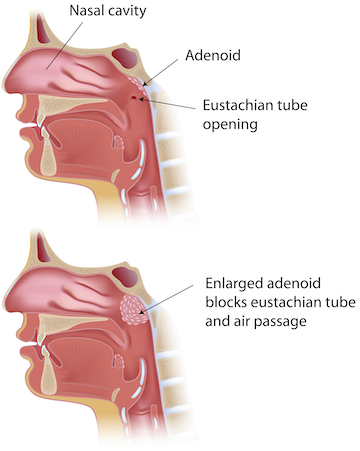Conditions: Tonsil and/or Adenoid Problems
The throat (pharynx) is a common site of infection. Symptoms may range from a nuisance to severe pain and/or blockage of the airway. Tonsils, adenoids, and lingual tonsils are a part (but not all) of the throat.
what and where are the tonsils and adenoids?
Tonsils (formally known as palatine tonsils) are the bulges on each side of the throat when you look in the mirror. Adenoids (formally nasopharyngeal tonsil) are the same type of tissue located at the very back of the nose and the top of the throat, rendering them out of sight without special instruments. Lingual tonsils are the same type of tissue located on the back of the tongue.
Child with large tonsils.
Tonsils depicted in bright red.
Types of problems tonsils and adenoids can cause
Essentially, there are three types of problems that tonsils and adenoids can exhibit: infection, airway narrowing, and cancer. Obstruction of the airway due to tonsil or adenoid enlargement is most common and most relevant among children. Infection problems usually correspond to ages 2 to middle adulthood. Tumors of tonsils or in the area of the adenoids are most commonly present between ages of 45 and 70.
What do tonsils and adenoids do and why are they present?
Adenoids, palatine tonsils, and lingual tonsils are structures rich in immune system cells, and are therefore part of the immune system, but their immune function seems to be complete very early in life (probably before birth). To date, there are no studies that demonstrate a significant clinical impact of tonsillectomy or adenoidectomy on the immune system, but tonsils, adenoids, and the lingual tonsils, often cause health problems, with infections, airway blockage, or tumors. Despite consisting of the same type of tissue, their anatomic differences account for their different potential health problems, with the adenoids relating to recurrent ear infections, frequent mucus discharge in children, and blockage of the nasal airway, while the tonsils potentially blocking air from the nose and mouth. So, one answer to the question, “what do they do” is “potentially cause problems, though they do not cause problems in everyone.”
Infection of the tonsils (tonsillitis), adenoids (adenoiditis), and lingual tonsils (lingual tonsillitis)
Infection of the tonsils, adenoids, and lingual tonsils, is common, and may be due to viruses or bacteria. An infection may predominate in one or more than one of these structures simultaneously. Most viral infections have run their course within a week with little intervention needed. One exception is mononucleosis, which is caused by the Epstin Barr Virus (EBV). Bacterial infections may also come and go relatively quickly without treatment, but they may persist longer. Statistically, an infection in the throat is more likely to be bacterial than viral if it has been present for more than 7-10 days. Thus, a key clinical indicator of whether a tonsil, adenoid, or lingual tonsil infection is bacterial is whether it has persisted for greater than a week or so. Tonsil stones (tonsillitis) may promote mild or more severe bacterial tonsillitis. Antibiotics (specifically antibacterials) have no effect on a viral infection, yet over-use of such antibiotics has many downsides, including risk of allergy or other side effects as well as promoting drug resistance.
Regardless of their size, adenoids may become infected and may stay infected for a variable length of time. Since the adenoids are positioned in-between the Eustachian tube openings, infection of the adenoids can allow bacteria to spread through the Eustachian tubes to the middle ear, causing a middle ear infection (otitis media). It is for this reason that removal of the adendoids (adenoidectomy) may be undertaken in addition to ear tube placement for otitis media, though adenoidectomy is typically reserved for a situation in which a second set of tubes is being placed.
Lingual tonsillitis is a condition that does not get much discussion, potentially because it may occur simultaneous to infection of the palatine tonsils and adenoids frequently, and since treatment of infection at one of these sites is often effective for all sites.
Tonsil stones (also known as tonsiloliths or tonsiliths)
Tonsil stones are collections of food, dead cells, and mucus that get trapped in the crypts of tonsils. They tend to harden and allow bacteria to thrive, sometimes causing inflammation and tonsillitis, pain and/or bad breath. Here’s a light-hearted video explaining tonsil stones in greater detail.
Adenoid-small and large.
enlarged Adenoids (adenoid hypertrophy)
Because of their location, enlarged adenoids may block the airway from the nose to the throat as well as block the openings of the Eustachian tubes. As the adenoids grow and progressively narrow that portion of the airway, one’s nasal airflow will be correspondingly restricted. When the blockage is partial and mild, the person’s voice might sound hypo nasal—that is, with less than normal sound and resonance coming from the nasal cavity. When the blockage is complete, an affected person’s voice will be oral only, which sounds characteristically “stuffy.” Also, one’s ability to breathe through the nose may be compromised by the presence of large adenoids. This may lead someone to predominantly or completely mouth breathe, which may be uncomfortable. In a person with obstructive sleep apnea, restriction of the nasal airway can also limit one’s ability to use a nasal-only mask with their CPAP machine. Generally, adenoid tissue naturally shrinks starting in early adulthood, so adenoid hypertrophy becomes less common after one’s 20s and 30s.
Enlarged Tonsils (tonsillar hypertrophy)
Whereas enlarged adenoids may restrict or block nasal airflow, enlarged tonsils, being further downstream in the airway, can block airflow from both nasal and oral breathing. While infected and inflamed tonsils may make swallowing painful, very large tonsils may also disrupt the mechanics of swallowing. Tonsils do tend to shrink with age, but unlike adenoids, the palatine tonsils regress much more slowly and it is not uncommon for individuals in their 40s or 50s to have moderately large tonsils. The tonsils are not always symmetrically equal in size, but usually are in the absence of a tumor.
Degrees of tonsillar hypertrophy. From left to right, 0+, 1+, 2+, 3+, and 4+ tonsils
Sleep disordered breathing and obstructive sleep apnea
As the muscles of the throat relax during sleep, enlarged tonsils and/or adenoids can cause worse problems with breathing during sleep, including obstructive sleep apnea, than while awake. The severity and consequence of sleep disordered breathing may range from mild to severe. Large tonsils and/or adenoids generally have a much more significant effect on the airway during sleep in children than in adults.
Cancer of the tonsils (palatine tonsils) or base of tongue (lingual tonsils)
Cancer may occur in the tonsils (palatine tonsils, technically) or the lingual tonsils at the base of the tongue. The most common types of cancer here are squamous cell carcinoma, which occurs rarely outside of the ages of 45 to 70, and lymphoma, which is quite uncommon but can occur in a broader age range, from children to the very elderly. Asymmetry of the palatine tonsils may be a hint that the larger tonsil has a cancer, but tonsillar asymmetry may also be due to more infection or inflammation in one tonsil.
Nasopharyngeal cancer
Nasopharyngeal cancer is a type of cancer that can arise in the nasopharynx, which is the anatomic location where the adenoid tissue exists. It is not clear whether the lymphatic tissue of the adenoids is the type of tissue that gives rise to nasopharyngeal carcinoma, but the clinical appearance of normal adenoid tissue and nasopharyngeal carcinoma may be similar in some ways, perhaps adding to the challenge in detecting nasopharyngeal cancer.
This page









